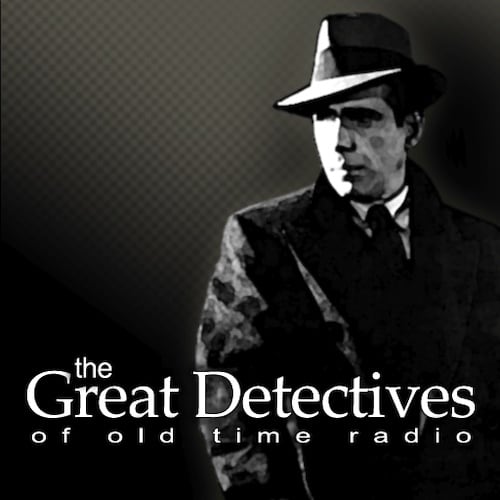Colonial Radio Theater:
Colonial Radio Theater began operating out of Boston in 1995. Of all American radio producers, they may have the greatest range of offerings. I could boil down others to a simple sentence that could boil down what they do. Jim French Productions thrived on producing mysteries. LA Theatre Works operates like a typical playhouse only performing their plays for audio. While these aren’t complete, they give you a gist of what the company does and specializes in. There are more than hundreds of productions put out by the Colonial Radio Theater and I can’t really boil down their output that neatly. The closest I could come to is saying that they mostly put out period pieces, but that feels more incidental than essential to what they’ve been doing for the past quarter century.
Powder River and Other Original Series: Powder River is their flagship series. They just released their thirteenth season chock full of half-hour Western adventures. In addition, they’ve also done some feature-length audio “movies.” In addition to that, they’ve also done other original series such as the Revolutionary War era series Ticonderoga. They also produced a series called Beacon Hill. following a wealthy family in Boston in 1898. The series was produced about the time that Downton Abbey was quite popular and played into that sort of story. They also produced comedy series such as The New Dibble Show and The Adventures of Sergeant Billy and Corporal Sam.
History: They did a lot of plays based on incidents from history, particularly American history. Notable among them are The Plimoth Adventure, the Alamo, Shiloh, Gettysburg, and Little Big Horn. These historic stories were known for their dedication to historical accuracy.
Public Domain Adaptations: The public domain has served Colonial Radio Theater well and vice versa. They’ve adapted productions that have been obvious choices for many radio theaters including Dickens’s The Christmas Carol. L. Frank Baum’s The Wizard of Oz, and Robert Louis Stevenson’s Treasure Island. However, they’ve also gone for some less obvious choices such as adapting Dickens’s other Christmas works, public domain sequels to the Wizard of Oz, as well as adapting a couple of the original Tom Swift novels from the early 20th Century.
Other adapted words included all the Jeeves and Wooster stories that were in the public domain at the time, all the stories in the first two Father Brown books, King Solomon’s Mine, 20,000 Leagues Under the Sea, and The Prince and the Pauper.
Licensed Adaptations: Colonial has produced work for a many licensed properties including Zorro and Perry Mason. They’ve also licensed some science fiction programs including Tom Corbett and Logan’s Run.
Perhaps, their most noted adaptations have been of the work of author Ray Bradbury, adapting four different novels. Their five-and-a-half-hour adaptation of the Martian Chronicles is one of their standouts.
Christmas Musical: In 2016, under the Family Audio Theater imprint, they also released Jimmy and the Star Angel, a children’s fantasy musical about two children who recently lost their father and find themselves shrunk down to ornament size and needing to journey to the top of the Christmas tree in order to be restored to normal.
Colonial was on Satellite radio for many years, and several of their productions were featured on Imagination Theater. Currently they feature on a few terrestrial and online radio stations while also selling their productions on CD and digital download through Audible.
Seeing Ear Theater
All the other productions from the 1990s I’ve talked about have carried on in one former or another. Seeing Ear Theater was different, but it was also an important trailblazer.
Seeing Ear Theater was released on the website of the SyFy channel (back when it was the Sci-Fi Channel) and featured original audio Science Fiction dramas. The dramas included obvious classics like Alice in Wonderland and The Time Machine as well as stories based on the work of more recent science fiction authors such as Octavia Butler, Neil Gaiman and Clive Barker. Babylon Five creator J. Michael Straczynski wrote an eight-episode serialized story for the series. The series also paid its respects to the golden age of radio with an adaptation of the most popular old-time radio story of all time, “Sorry, Wrong Number.” While a lot of lesser known actors appeared, there were some more notable talent, including Mark Hamill, Lou Diamond Phillips, Bronson Pinchot, Tony Danza, and Stanley Tucci. They even had one comedy episode featuring the stars of Mystery Science Theater (the eighth-tenth seasons of the show aired on the Sci-Fi Channel.)
The series didn’t seem to have any major commercial agenda despite a few stories being released on audio cassette. It seemed to be an effort out of love for radio drama as well as a desire to promote the Sci-Fi channel website.
I remember being interested in it, but one word summarized my experience with the series…”buffering.” Seeing Ear Theatre released its episodes from 1997-2001, at the peak of dial-up internet popularity, before broadband connections became more common. In that era, a long-form video series on the Internet was impossible, but audio wasn’t much easier. This limited the reach of the series.
Yet, in retrospect, Seeing Ear Theater deserves credit for pointing to the Internet as the home for audio dramas. Since that series’ original release, Internet connections have gotten faster and hard drives have increased storage capacities. This has allowed greater distribution of audio dramas over the Internet. The Internet would become home to many original audio dramas, either downloaded off individual websites or available as podcasts. Few of these would have the star power that Seeing Ear Theater commanded, but these successor Internet audio dramas have the benefit of mobile devices and not having to deal with the headaches of dial-up.
